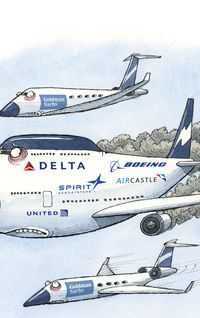On a roll
The year in the European high-yield market started much as the previous one had finished, with the market seemingly open to all-comers. But when the Covid crash came in February, high-yield bankers found themselves in the eye of the storm. For its ability to guide clients through the turmoil, Goldman Sachs is IFR's Europe High-Yield Bond House.
![]()
Goldman Sachs' deal roster in 2020 speaks for itself: ThyssenKrupp Elevators, one of the largest leveraged buyouts in a decade; Virgin Media and O2, the largest financing from a UK issuer since 2013; and Rolls-Royce, the largest offering by a European fallen angel in the aftermath of the Covid-19 outbreak.
"We took a leadership role in the crisis, and set records, placing ThyssenKrupp – one of the largest LBOs in recent history – and acting in support of post-Covid-19 fallen angels including Fiat Chrysler Automobiles and Rolls-Royce," said Michael Marsh, Goldman’s co-head of global credit finance.
"We were also there for lower-rated credits that were experiencing structural problems in their business. Most importantly, we didn't run away when the markets traded off."
The €10.3bn financing that backed ThyssenKrupp Elevator's buyout was one of the most anticipated deals of the year.
Sponsors Advent, Cinven and RAG Foundation had agreed the €17.2bn acquisition of ThyssenKrupp's elevators division in February. That meant it was underwritten with a debt financing put together before the coronavirus pandemic disrupted the markets – and before yields had rocketed.
But careful timing and execution meant the €4.055bn-equivalent bond, split across euros and US dollars, ended up with bumper orders of more than €25bn, allaying any fears over selling such a large deal during the pandemic – and setting the standard for post-coronavirus deals.
"When ThyssenKrupp came out, and was as successful as it was, it transformed people's expectations of the market," said Luke Gillam, co-head of leveraged finance capital markets for EMEA.
Some investors may have been hoping for Goldman and other underwriters to push the panic button and start selling – but the bank knew it just had to wait for market stability, he said. Pre-placing a €2bn PIK – which Goldman Principal Investments anchored – shortly after underwriting the deal helped. But the bank's skills and breadth of distribution were also important in getting the deal away.
"Some people had assumed that banks had underwritten a huge deal and that it was too large to be absorbed. But we knew we just had to be patient – it was a fundamentally good deal, from a good company," said Gillam.
The success of the TKE deal paved the way for other leveraged buyouts, including those that were more affected by Covid-19.
They included UK pub company Stonegate's €1.344bn-equivalent dual-currency senior secured M&A bond in July – one of the largest sterling bonds in the high-yield market, and a deal that came just weeks after UK pubs reopened after lockdown.
Give me Liberty …
Away from LBOs, one of Goldman’s most high-profile deals was the sterling high-yield bond component of the £5.7bn debt package that helped finance the US$38bn tie-up of Liberty Global’s Virgin Media and Telefonica’s O2. The deal was oversubscribed despite the M&A not closing until 2021.
“Liberty is known as probably one of the most demanding clients in terms of squeezing out value,” said Dominic Ashcroft, co-head of leveraged finance capital markets for EMEA. “It doesn’t want to leave anything on the table.”
Goldman was also there when its clients needed it to survive. Take UK aero engine maker Rolls-Royce, which needed £5bn to pull through the pandemic while aircraft were grounded globally.
The high-yield bond was a crucial addition to the rescue financing because it was significant in convincing investors that the company could access the capital markets.
The company's equity rallied 50% during the debt roadshow, while banks ended up doubling the bond's target size to £2bn across three tranches, giving the capital raise a boost and making the other components an easier sell.
"There was so much uncertainty in the market, but we saw this as an opportunity to solve the company's financial problems," said Ashcroft.
"A lot of investors were focused on the company's liquidity problems. We were able to project out that even if the crisis was worse than first thought, Rolls-Royce would still be able to get through it."
To see the digital version of this report, please click here
To purchase printed copies or a PDF of this report, please email gloria.balbastro@lseg.com


